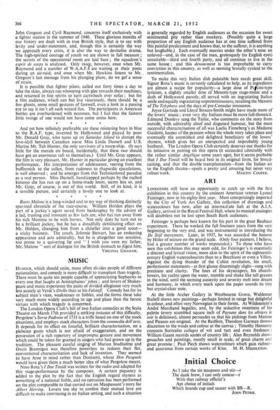AR1
LONDONERS still have an opportunity to catch up with the first _exhibition in this country by the 'eminent American veteran Lyonel Feininger, now in his eighty-first year. Most enterprisingly imported by the City of York Art Gallery, this collection of drawings and watercolours has now, after an intermediate halt at the A.I.A. Gallery, arrived in the Royal Festival Hall, where its musical analogies will doubtless not be lost upon South Bank audiences.
Feininger is perhaps best known for his part in the great Bauhaus experiment.. There he worked the full fourteen years from the very beginning to the very end, and was instrumental in introducing the De Stijl movement. Later, in 1937, he was accorded the honour by Hitler of seizure on the grand scale. _(Only four painters, I believe, had a greater number of works impounded.) To those who have seen this exhibition this may seem odd, for Feininger's is essentially a discreet and lyrical vision, more akin to the spirit of the eighteenth- century English watercolourists than to a Bocchioni or even a Villon. Against- the dying thunder of the Cubist revolution, his small, perfectionist statements—at first glance disarmingly slight—rang with precision and clarity. The lines of his skyscrapers, his church- towers, his yachts upon the water, tremble and shake like tall grasses in the wind, until the seeming austerity and severity melt into dream and harmony, in which every mark upon the paper sounds its tiny but crystal-clear note.
At the little Archer Gallery in Westboume Grove, Waldemar Stabell shows new paintings—perhaps limited in range but delightful in colour, and often very Norwegian in their forms. At Wildenstein's Andre Marchand beguiles, and, by the seductive sweetness of his palette (every scumbled square inch of Paysans dans les oliviers le soir is delicious), almost persuades us that his pickings from Matisse and Picasso are original. At the Redfern, Theodore Garman throws discretion to the winds and colour at the canvas ; Timothy Hennessy concocts Surrealist collages of wit and tact and even freshness ; William Gaunt records scenes of country life ; Alan Reynolds shows gouaches and paintings, mostly small in scale, of great charm and great promise ; Paul Piech shoWs watercolours which gain richness and assurance from certain works of Klee. M. H. MiDoLuroN.


































 Previous page
Previous page